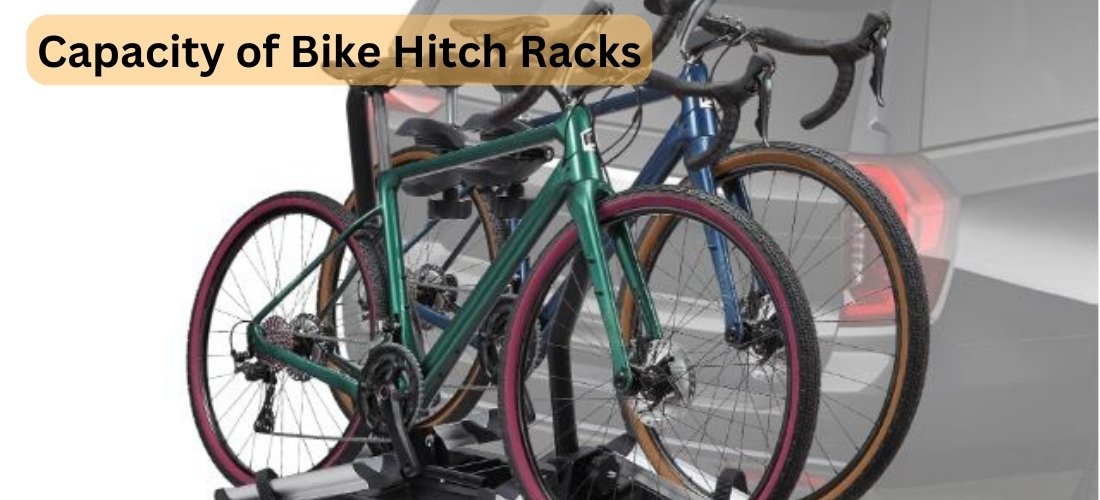Ever stood scratching your head, staring at a capacity of bike hitch racks, wondering just how many bikes can you safely load onto without turning your road trip into a roadside circus? You’re not alone! This guide is your one-stop-shop to understanding everything about bike hitch rack capacities, how much weight they can bear, and the do’s and don’ts to avoid a rack-wreck disaster. So, buckle up (or should we say, “rack up”?) as we dive into the nitty-gritty of safely transporting your two-wheeled treasures.
Hitch Rack 101: The Basics
First off, let’s talk about what a bike hitch rack is. Simply put, it’s a type of bike rack that attaches to the hitch of your vehicle, offering a sturdy and convenient way to haul bikes. But not all hitch racks are created equal, and knowing their limits is key to a worry-free journey.
Capacity: Not Just a Number
- How Much Weight Can a Bike Rack Hold? The weight capacity of bike hitch racks varies widely, typically ranging from 35 to 70 pounds per bike. However, some heavy-duty models can carry more, especially those designed for electric bikes. But remember, it’s not just about the weight of the bikes; it’s about how this weight is distributed. More on this later.
- Types of Hitch Racks and Their Capacities:
- Platform Racks: Known for their stability, these can generally hold more weight, making them ideal for heavier bikes.
- Hanging Racks: While they might allow for more bikes to be carried, they usually have a lower weight limit per bike.
The Weighty Consequences of Overloading
Loading your hitch rack beyond its capacity is like inviting a troupe of elephants to a trampoline party—something’s got to give. Here’s what can happen:
- Damage to Your Rack: Overloading can lead to bent frames or, worse, a total rack failure. Imagine your bikes doing a high-speed tango down the highway—not a pretty sight.
- Damage to Your Vehicle: Excess weight can also wreak havoc on your vehicle’s hitch receiver and suspension.
- Safety Hazards: Besides the risk of losing your bikes, overloading can affect your vehicle’s handling, braking, and overall safety on the road.
Tips for a Safe and Secure Load-Up
- Know Your Limits: Check both your rack’s and your vehicle’s hitch weight capacity. The lowest number between the two is your max capacity.
- Even Steven: Distribute the weight evenly across the rack to avoid undue stress on one side.
- Secure and Check: Always double-check that your bikes are secured tightly. A wobbly bike is a no-go.
- Accessorize Wisely: If you’re using add-ons or extensions, remember they also eat into your weight limit.
FAQs
1. What is the average weight capacity of a bike hitch rack?
The average weight capacity of bike hitch racks typically ranges between 35 to 70 pounds per bike. However, this can vary depending on the design and model of the rack. Heavy-duty racks designed for e-bikes or larger bikes may support more weight.
2. How do I know if my bike is too heavy for my rack?
First, check the weight limit specified by the manufacturer of your bike rack. You should then weigh your bike (a quick internet search can provide average weights for your bike type if you don’t have a scale) to ensure it falls within the rack’s capacity. Remember to include the weight of any additional accessories or equipment attached to your bike.
3. Can I carry more bikes by using an extender or additional accessories?
While extenders and additional accessories can increase the number of bikes you can carry, they do not increase the overall weight capacity of your hitch rack. It’s important to calculate the total weight of all bikes and accessories to ensure you do not exceed the rack’s weight limit.
4. What happens if I exceed the weight capacity of my bike hitch rack?
Exceeding the weight capacity can lead to several issues, including damage to your bike rack, bikes, or vehicle. It can also pose significant safety risks, such as the rack detaching from your vehicle while driving. Always adhere to the specified weight limits to avoid accidents and damage.
5. Are there bike racks specifically designed for heavier bikes, like e-bikes?
Yes, there are bike racks designed to accommodate the additional weight of e-bikes and other heavy bikes. These racks typically have a higher weight capacity per bike and may include features like ramps for easier loading. It’s important to choose a rack that meets the specific needs of your bike to ensure safe and secure transportation.
Conclusion
In conclusion, our deep dive into the capacities of bike hitch racks has armed you with the crucial knowledge to make informed decisions about transporting your bikes safely and efficiently. Understanding the weight capacity of your bike rack and the potential consequences of overloading are paramount to ensuring the safety of your bikes, your vehicle, and fellow road users. We’ve covered the importance of choosing the right type of rack for your needs, how to evenly distribute the weight of your bikes, and the vital practice of securing your bikes properly. This guide aims to transform the way you approach bike transportation, turning potential headaches into seamless adventures. By respecting the limitations of your equipment and applying these best practices, you’re not just protecting your gear—you’re paving the way for countless stress-free journeys.
Holding an MSC-IT from the University of Gujrat, I boast two years in website development, certifications in SEO, and graphic design from e-Rozgar, and an Amazon course completion. As “Fashion Vogue’s” owner and a seasoned freelancer on Upwork for three years, my expertise spans IT, digital marketing, and e-commerce.

